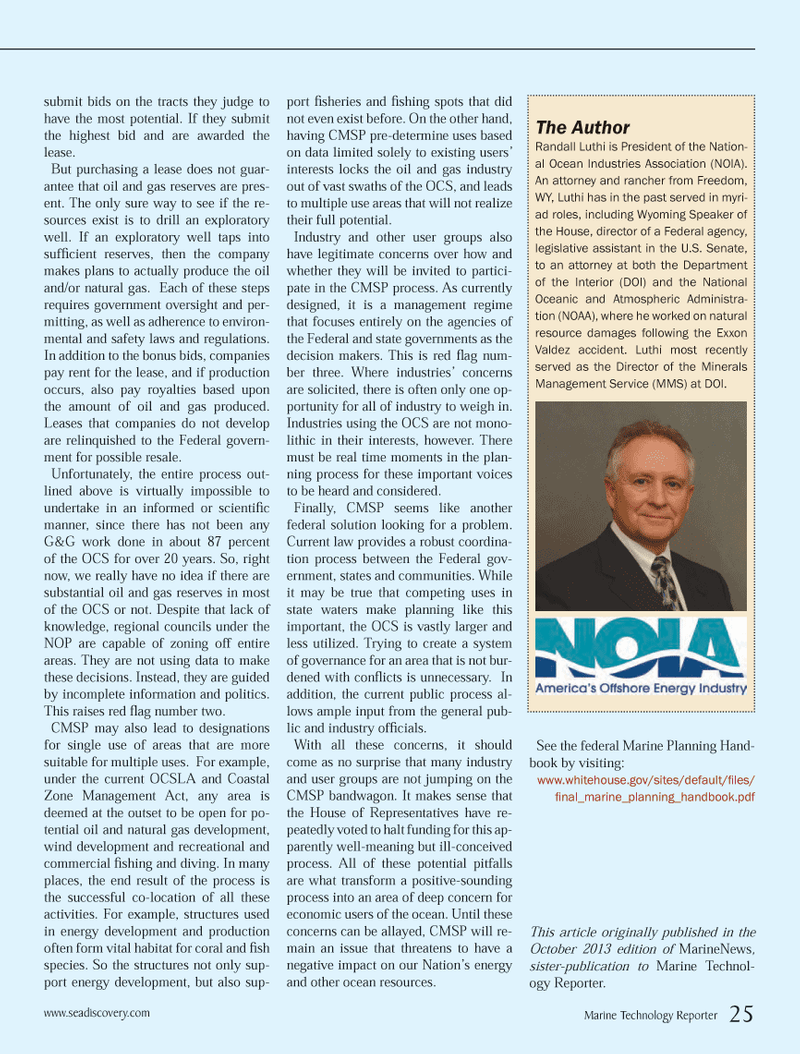
Page 25: of Marine Technology Magazine (October 2013)
Subsea Defense
Read this page in Pdf, Flash or Html5 edition of October 2013 Marine Technology Magazine
submit bids on the tracts they judge to have the most potential. If they submit the highest bid and are awarded the lease. But purchasing a lease does not guar- antee that oil and gas reserves are pres- ent. The only sure way to see if the re- sources exist is to drill an exploratory well. If an exploratory well taps into sufÞ cient reserves, then the company makes plans to actually produce the oil and/or natural gas. Each of these steps requires government oversight and per- mitting, as well as adherence to environ- mental and safety laws and regulations. In addition to the bonus bids, companies pay rent for the lease, and if production occurs, also pay royalties based upon the amount of oil and gas produced. Leases that companies do not develop are relinquished to the Federal govern- ment for possible resale. Unfortunately, the entire process out- lined above is virtually impossible to undertake in an informed or scientiÞ c manner, since there has not been any G&G work done in about 87 percent of the OCS for over 20 years. So, right now, we really have no idea if there are substantial oil and gas reserves in most of the OCS or not. Despite that lack of knowledge, regional councils under the NOP are capable of zoning off entire areas. They are not using data to make these decisions. Instead, they are guided by incomplete information and politics. This raises red ß ag number two. CMSP may also lead to designations for single use of areas that are more suitable for multiple uses. For example, under the current OCSLA and Coastal Zone Management Act, any area is deemed at the outset to be open for po-tential oil and natural gas development, wind development and recreational and commercial Þ shing and diving. In many places, the end result of the process is the successful co-location of all these activities. For example, structures used in energy development and production often form vital habitat for coral and Þ sh species. So the structures not only sup-port energy development, but also sup- port Þ sheries and Þ shing spots that did not even exist before. On the other hand, having CMSP pre-determine uses based on data limited solely to existing usersÕ interests locks the oil and gas industry out of vast swaths of the OCS, and leads to multiple use areas that will not realize their full potential. Industry and other user groups also have legitimate concerns over how and whether they will be invited to partici- pate in the CMSP process. As currently designed, it is a management regime that focuses entirely on the agencies of the Federal and state governments as the decision makers. This is red ß ag num- ber three. Where industriesÕ concerns are solicited, there is often only one op-portunity for all of industry to weigh in. Industries using the OCS are not mono-lithic in their interests, however. There must be real time moments in the plan-ning process for these important voices to be heard and considered.Finally, CMSP seems like another federal solution looking for a problem. Current law provides a robust coordina- tion process between the Federal gov- ernment, states and communities. While it may be true that competing uses in state waters make planning like this important, the OCS is vastly larger and less utilized. Trying to create a system of governance for an area that is not bur- dened with conß icts is unnecessary. In addition, the current public process al-lows ample input from the general pub- lic and industry ofÞ cials. With all these concerns, it should come as no surprise that many industry and user groups are not jumping on the CMSP bandwagon. It makes sense that the House of Representatives have re- peatedly voted to halt funding for this ap- parently well-meaning but ill-conceived process. All of these potential pitfalls are what transform a positive-sounding process into an area of deep concern for economic users of the ocean. Until these concerns can be allayed, CMSP will re-main an issue that threatens to have a negative impact on our NationÕs energy and other ocean resources. See the federal Marine Planning Hand-book by visiting:www.whitehouse.gov/sites/default/ Þ les/Þ nal_marine_planning_handbook.pdf This article originally published in the October 2013 edition of MarineNews , sister-publication to Marine Technol- ogy Reporter. The AuthorRandall Luthi is President of the Nation- al Ocean Industries Association (NOIA). An attorney and rancher from Freedom, WY, Luthi has in the past served in myri- ad roles, including Wyoming Speaker of the House, director of a Federal agency, legislative assistant in the U.S. Senate, to an attorney at both the Department of the Interior (DOI) and the National Oceanic and Atmospheric Administra- tion (NOAA), where he worked on natural resource damages following the Exxon Valdez accident. Luthi most recently served as the Director of the Minerals Management Service (MMS) at DOI. Marine Technology Reporter 25www.seadiscovery.com MTR #8 (18-33).indd 25MTR #8 (18-33).indd 2510/15/2013 4:06:08 PM10/15/2013 4:06:08 PM

 24
24

 26
26
